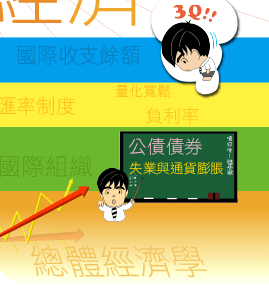




[考題 105 北大經濟所 個體經濟學 第4題]
Charlie depends on financial aid to attend college and usually has equal chances to experience a tough (T) or an easy (E) semester. His expected utility function is of following form: . Suppose he needs to choose one of the two majors before school starts and each associates with different financial aid prospects:
. Suppose he needs to choose one of the two majors before school starts and each associates with different financial aid prospects:
|
major |
Financial aid |
Financial aid |
|
Economics |
$40,000 |
$50,000 |
|
Mathematics |
$75,000 |
$18,000 |
(1) Which major should Charlie choose?
(2) If there is a new program that allows students to mix the courses of these two majors, what is the mix that maximizes Charlie’s expected utility?
[解答]
(1)當兩個主修只能選一個時,分別計算兩者的預期效用值。
若選擇經濟(Economics): 
若選擇數學(Mathematics):
可知經濟的預期效用較高,故Charlie應該選擇經濟作為主修。
(2)若允許混和兩個專業課程作為主修,則Charlie應選擇一組混和的比例極大預期效用,假設經濟的比重為α、數學的比重為1-α。

由一階條件(F.O.C)可得

整理可得


表示Charlie應該混和兩門專業將73%比重選擇經濟、27%比重選擇數學。
(經濟直覺:由Charlie的預期效用可知,他屬於風險趨避者,數學的獎助金兩種情況比較極端,而經濟的分布比較集中,故會選擇較多的權重放置於經濟,以符合預期效用極大)- 面授課程:高普考
- 雲端課程:經濟學、公共經濟學、財政學、租稅各論
- 考試用書:經濟學(概要)、經濟學測驗題完全制霸、財政學大意歷屆試題分章題解

